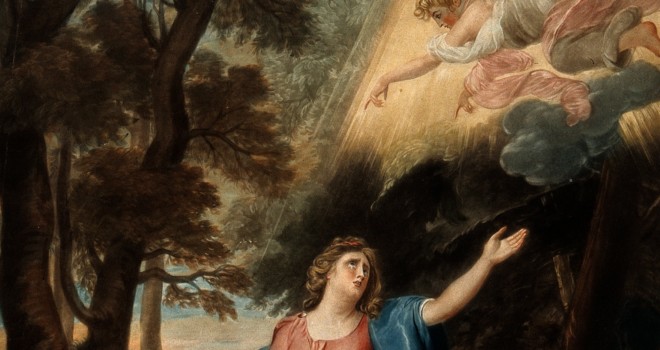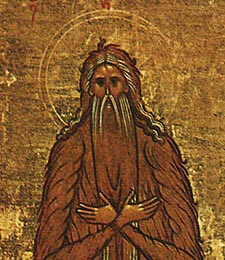Something extraordinary happens when the slave Hagar
runs away from Sarah into the wilderness.
In the wilderness, she encounters an angel of the
Lord who asks her why she is running away. Hagar explains and the angel tells
her to return. That request is followed by a promise:
You are now pregnant and shall bear a son;
you shall name him Ishmael,
For the LORD has heeded your affliction.
He shall be a wild ass of a man,
his hand against everyone,
and everyone’s hand against him;
Alongside all his kindred
shall he encamp.(Genesis 16:11-12)
For the LORD has heeded your affliction.
He shall be a wild ass of a man,
his hand against everyone,
and everyone’s hand against him;
Alongside all his kindred
shall he encamp.”Genesis 16:11-12
The episode is remarkable for a number of reasons. First, the angel of the Lord, who could be interpreted as a pre-Incarnate Christ, begins in the same way that many other encounters do in the Old Testament, going all the way back to when Adam and Eve were hiding from God in the garden. He begins with a question—not in order to learn why she is there, because surely the angel already knew this. Instead, He endeavors to begin a dialogue with her, to relate to her on a personal level.
Second, the angel’s arrival does not address any
pressing material need. We are familiar with the archetype of the forlorn
wander in the dessert, dying of starvation and thirst. But that’s not what
happens here. When the angel finds her, Hagar is already near a spring (verse 7).
Third, the angel delivers a perplexing command: he
tells her to return to her oppressor, Sarah. As one
Jewish commentary explains, the
angel’s directive can better be understood when understood in the broader
context of the Old Testament, in which a period of enslavement is then followed
by liberation. Moreover, in context, Hagar’s submission is also tied to the
future prosperity of her descendants.
But there could be one more reason why Hagar is
asked to return. In encountering God through the angel she has experienced a
kind of liberation that is internal and spiritual, such that external
enslavement can no longer rob her of her interior peace. Having met God, she is
now ready to endure the trial of material slavery.
The ending of the account seems to support this
conclusion. It is there that we get our big surprise: Hagar names God.
To the LORD who spoke to her she gave a name, saying, “You are God who sees me” (verse 13).
This is extraordinary reversal of what is expected.
First, we would expect someone of higher social or religious status to be
granted the privilege of giving God a name. Second, even those of higher rank
are often denied such a privilege. Instead, God is the one to name Himself. The
obvious example of this is Moses, to whom God reveals His name as ‘I Am Who I
Am.’
The name Hagar ascribes to God reveals something
about important about who He sees her. In this account, Hagar has encountered
God’s loving vision and it is this vision that has liberated her, enabling her
to return to Sarah.
The impact of God’s vision is evident the next time
Hagar flees into the wilderness, in Genesis
21. This time she cannot
find a spring and her skin of water runs out. Hagar’s son Ishmael is at risk of
dying of thirst. Hagar is so distraught she puts him down and then walks the
distance of a bowshot away because she cannot bear to watch him die. God hears
the boy crying and intervenes:
God’s angel called to Hagar from heaven: “What is the matter, Hagar? Do not fear; God has heard the boy’s voice in this plight of his. Get up, lift up the boy and hold him by the hand; for I will make of him a great nation.” Then God opened her eyes, and she saw a well of water. She went and filled the skin with water, and then let the boy drink (verses 17-19).
In her first wilderness encounter, Hagar recognizes
God as one who sees her. Now her eyes are opened. Her reality is transformed. She
can see refreshing waters where none were visible before. In gazing upon her,
God has changed her own way of seeing—not just in material terms, but also in a
spiritual sense.
We can understand this dynamic by considering Christ
on the cross. One well-known devotional work
examines what Christ saw from the cross, such as “His Father’s house” and the
Mount of Olives. But most importantly Christ saw us—sinful humanity. We spend
so much time looking at the crucifix today we can forget that Christ looks back at us. This literally happens in the Eucharist,
in which Christ continues to gaze lovingly upon us from behind the veil of the
bread.
And just like Hagar our own vision is transformed.
In looking at us, Christ shows us the Father’s love for us, and we are
introduced to a new way of seeing ourselves and the world around us. The
encyclical Lumen Fidei, in a section likely authored by Pope Benedict XVI,
explains how:
The self-awareness of the believer now expands because of the presence of another; it now lives in this other and thus, in love, life takes on a whole new breadth. Here we see the Holy Spirit at work. The Christian can see with the eyes of Jesus and share in his mind, his filial disposition, because he or she shares in his love, which is the Spirit. In the love of Jesus, we receive in a certain way his vision.
May we all, when we find ourselves in the desolation of our own personal wilderness, come to know the God who sees us and, in so knowing, may our own vision be transformed so that we may see the springs of eternal life that await us.
✠
image: “Hagar Saved by an Angel” Robert Dunkarton [CC BY 4.0], via Wikimedia Commons















